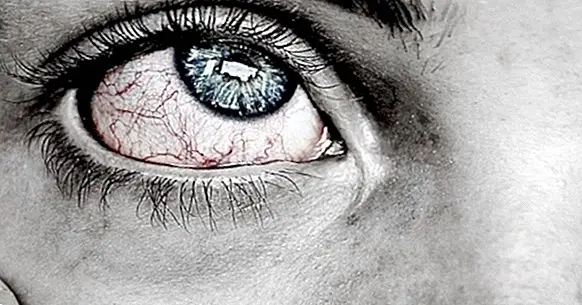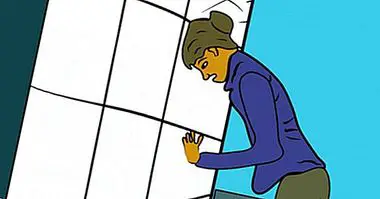Chronic pain: what it is and how it is treated from the Psychology
The chronic pain , that whose duration exceeds six months, is an experience not only distinct from acute pain in a quantitative way, but also, and above all, qualitatively. How can you face it? To know it, first it is necessary to explore what pain is.
How does the pain work?
The idea that the feeling of pain depends solely on the physical damage produced (simple linear model) has been maintained for a long period of time. However, this way of understanding pain is considered insufficient to explain some clinical phenomena.
What happens to the phantom limb pain? And with the placebo effect? Why does it seem that the pain intensifies when being silent, in the darkness of the night, when we are in bed without any kind of distraction?
Melzack and Wall proposed in 1965 the Theory of the Gate of Control , which holds that pain is composed of three dimensions:
- Sensory or Discriminative : alludes to physical properties of pain.
- Motivational or Affective : referred to emotional aspects of it.
- Cognitive or Evaluative : relative to the interpretation of pain according to attentional aspects, previous experiences, the sociocultural context ....
What influence do these factors have? The perception of noxious stimuli is not direct, but there is a modulation of the message at the level of the spinal cord. This implies that in order to feel pain the arrival of a "pain" to the brain is necessary. However, does the brain always receive this information?
The pain valve
According to the authors, there is a gate that allows (or not) the entry of this information to the neural pathway , depending on whether it is opened or closed. The previously mentioned dimensions are the physical, emotional and cognitive factors, which control its opening or closing
In the last decade, Melzack has proposed a Neural Networks Model which postulates that, although pain processing is genetically determined, it can be modified by experience. In this way, the factors that increase the sensory flow of pain signals, in the long term could modify the thresholds of excitability, thus increasing sensitivity to it.
Currently, there is no point in talking about psychogenic pain and organic pain. Simply, in humans, the pain is always influenced by psychological factors , which means that in its experimentation not only goes from the pain receptors to the brain, but also in the opposite direction.
Strategies to deal with chronic pain
What strategies do patients with chronic pain use to try to solve it?
Among them are:
- Attention distraction .
- Self-affirmations : telling oneself that one can face pain without great difficulties.
- Ignore the sensations of pain.
- Increase your activity level : through the use of distracting behaviors.
- Search for support Social.
Different scientific studies have tried to find out which of them are truly effective. However, the results are inconclusive, except for what is known about a bad strategy: catastrophism.
What is catastrophism?
Catastrophism is defined as the set of very negative thoughts referred to the pain has no end, no solution , nothing can be done to improve it.
The work done at Dalhousie University in Halifax by Sullivan and his team distinguish three dimensions in the assessment of catastrophism. These refer to the inability to remove the pain (rumination) from the patient's mind, the exaggeration of the threatening properties of the painful stimulus (magnification) and the feeling of inability to influence the pain (helplessness). The results suggest that rumination is more consistently related to this strategy.
The pain scheme
Pain, as unpleasant emotion, is associated with unpleasant emotions and thoughts . To try to improve their quality of life, people try to suppress them. However, not only do they not achieve it, but they also make it stronger (producing the rumination that will keep them active continuously).
This activation is associated, in turn, with other negative emotions, which strengthens the catastrophic scheme, which consequently biases the cognitive and emotional processes of the person, contributing, again, to the persistence of pain. In this way, you enter a vicious circle. How to get out of it?
Intervention of psychology in chronic pain
Setting the goal of eliminating chronic pain can be not only ineffective, but also harmful to the patient, as well as an intervention aimed at promoting positive thoughts and emotions in this regard. As an alternative, the role of acceptance and Contextual therapy l in chronic pain.
The role of acceptance
Acceptance consists in the selective application of control to that which is controllable (unlike resignation, which tries to replace control by the absence of absolute control). From this point of view, psychological interventions propose to patients strategies to improve their quality of life in a life with pain, without trying to eliminate it.
Although there are still few investigations in this line, a study conducted at the University of Chicago shows that People with greater acceptance of pain show lower values of anxiety and depression , in addition to a higher level of activity and employment status.
Contextual Therapy
Contextual Therapy or Acceptance and Commitment Therapy, developed by Hayes and Wilson, has been scarcely applied to chronic pain for the time being. Is it consists of changing the function of the patient's emotions and thoughts (do not modify them in themselves). In this way, patients are tried to experience that emotions and thoughts happen to them, but they are not the cause of their behavior, thus coming to consider what are the values that act as the motor of it.
With respect to pain, he tries to assume his presence without trying to suppress it, getting involved in other vital activities oriented to different objectives.
Bibliographic references:
- Fernández Berrocal, P., & Ramos Díaz, N. (2002). Smart hearts Barcelona: Kairós.



















